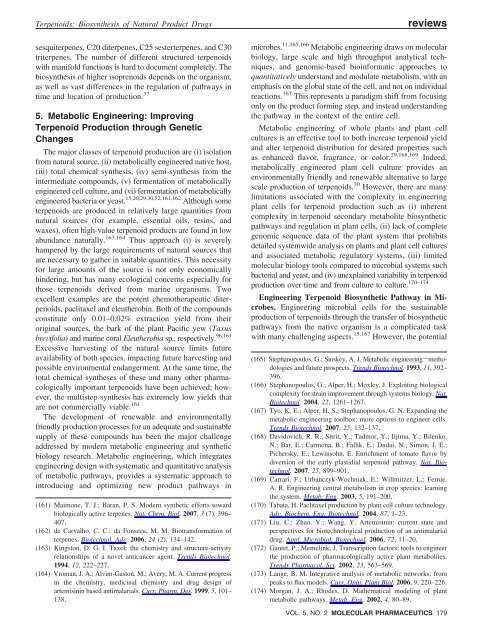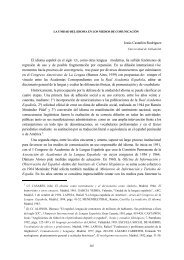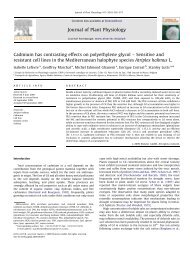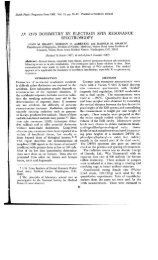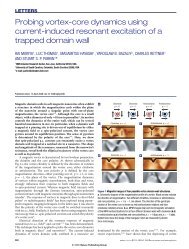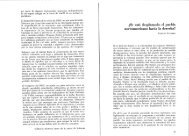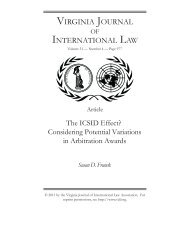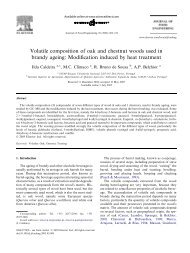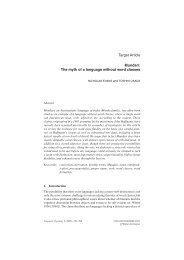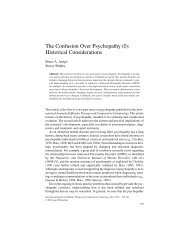Terpenoids: Opportunities for Biosynthesis of Natural Product Drugs ...
Terpenoids: Opportunities for Biosynthesis of Natural Product Drugs ...
Terpenoids: Opportunities for Biosynthesis of Natural Product Drugs ...
You also want an ePaper? Increase the reach of your titles
YUMPU automatically turns print PDFs into web optimized ePapers that Google loves.
<strong>Terpenoids</strong>: <strong>Biosynthesis</strong> <strong>of</strong> <strong>Natural</strong> <strong>Product</strong> <strong>Drugs</strong> reviews<br />
sesquiterpenes, C20 diterpenes, C25 sesterterpenes, and C30<br />
triterpenes. The number <strong>of</strong> different structured terpenoids<br />
with manifold functions is hard to document completely. The<br />
biosynthesis <strong>of</strong> higher isoprenoids depends on the organism,<br />
as well as vast differences in the regulation <strong>of</strong> pathways in<br />
time and location <strong>of</strong> production. 37<br />
5. Metabolic Engineering: Improving<br />
Terpenoid <strong>Product</strong>ion through Genetic<br />
Changes<br />
The major classes <strong>of</strong> terpenoid production are (i) isolation<br />
from natural source, (ii) metabolically engineered native host,<br />
(iii) total chemical synthesis, (iv) semi-synthesis from the<br />
intermediate compounds, (v) fermentation <strong>of</strong> metabolically<br />
engineered cell culture, and (vi) fermentation <strong>of</strong> metabolically<br />
engineered bacteria or yeast. 15,20,29,30,52,161,162 Although some<br />
terpenoids are produced in relatively large quantities from<br />
natural sources (<strong>for</strong> example, essential oils, resins, and<br />
waxes), <strong>of</strong>ten high-value terpenoid products are found in low<br />
abundance naturally. 163,164 Thus approach (i) is severely<br />
hampered by the large requirements <strong>of</strong> natural sources that<br />
are necessary to gather in suitable quantities. This necessity<br />
<strong>for</strong> large amounts <strong>of</strong> the source is not only economically<br />
hindering, but has many ecological concerns especially <strong>for</strong><br />
those terpenoids derived from marine organisms. Two<br />
excellent examples are the potent chemotherapeutic diterpenoids,<br />
paclitaxel and eleutherobin. Both <strong>of</strong> the compounds<br />
constitute only 0.01–0.02% extraction yield from their<br />
original sources, the bark <strong>of</strong> the plant Pacific yew (Taxus<br />
breVifolia) and marine coral Eleutherobia sp., respectively. 96,163<br />
Excessive harvesting <strong>of</strong> the natural source limits future<br />
availability <strong>of</strong> both species, impacting future harvesting and<br />
possible environmental endangerment. At the same time, the<br />
total chemical syntheses <strong>of</strong> these and many other pharmacologically<br />
important terpenoids have been achieved; however,<br />
the multistep synthesis has extremely low yields that<br />
are not commercially viable. 161<br />
The development <strong>of</strong> renewable and environmentally<br />
friendly production processes <strong>for</strong> an adequate and sustainable<br />
supply <strong>of</strong> these compounds has been the major challenge<br />
addressed by modern metabolic engineering and synthetic<br />
biology research. Metabolic engineering, which integrates<br />
engineering design with systematic and quantitative analysis<br />
<strong>of</strong> metabolic pathways, provides a systematic approach to<br />
introducing and optimizing new product pathways in<br />
(161) Maimone, T. J.; Baran, P. S. Modern synthetic ef<strong>for</strong>ts toward<br />
biologically active terpenes. Nat. Chem. Biol. 2007, 3 (7), 396–<br />
407.<br />
(162) de Carvalho, C. C.; da Fonseca, M. M. Biotrans<strong>for</strong>mation <strong>of</strong><br />
terpenes. Biotechnol. AdV. 2006, 24 (2), 134–142.<br />
(163) Kingston, D. G. I. Taxol: the chemistry and structure-activity<br />
relationships <strong>of</strong> a novel anticancer agent. Trends Biotechnol.<br />
1994, 12, 222–227.<br />
(164) Vroman, J. A.; Alvim-Gaston, M.; Avery, M. A. Current progress<br />
in the chemistry, medicinal chemistry and drug design <strong>of</strong><br />
artemisinin based antimalarials. Curr. Pharm. Des. 1999, 5, 101–<br />
138.<br />
microbes. 11,165,166 Metabolic engineering draws on molecular<br />
biology, large scale and high throughput analytical techniques,<br />
and genomic-based bioin<strong>for</strong>matic approaches to<br />
quantitatiVely understand and modulate metabolism, with an<br />
emphasis on the global state <strong>of</strong> the cell, and not on individual<br />
reactions. 167 This represents a paradigm shift from focusing<br />
only on the product <strong>for</strong>ming step, and instead understanding<br />
the pathway in the context <strong>of</strong> the entire cell.<br />
Metabolic engineering <strong>of</strong> whole plants and plant cell<br />
cultures is an effective tool to both increase terpenoid yield<br />
and alter terpenoid distribution <strong>for</strong> desired properties such<br />
as enhanced flavor, fragrance, or color. 29,168,169 Indeed,<br />
metabolically engineered plant cell culture provides an<br />
environmentally friendly and renewable alternative to large<br />
scale production <strong>of</strong> terpenoids. 30 However, there are many<br />
limitations associated with the complexity in engineering<br />
plant cells <strong>for</strong> terpenoid production such as (i) inherent<br />
complexity in terpenoid secondary metabolite biosynthetic<br />
pathways and regulation in plant cells, (ii) lack <strong>of</strong> complete<br />
genomic sequence data <strong>of</strong> the plant system that prohibits<br />
detailed systemwide analysis on plants and plant cell cultures<br />
and associated metabolic regulatory systems, (iii) limited<br />
molecular biology tools compared to microbial systems such<br />
bacterial and yeast, and (iv) unexplained variability in terpenoid<br />
production over time and from culture to culture. 170–174<br />
Engineering Terpenoid Biosynthetic Pathway in Microbes.<br />
Engineering microbial cells <strong>for</strong> the sustainable<br />
production <strong>of</strong> terpenoids through the transfer <strong>of</strong> biosynthetic<br />
pathways from the native organism is a complicated task<br />
with many challenging aspects. 15,167 However, the potential<br />
(165) Stephanopoulos, G.; Sinskey, A. J. Metabolic engineeringsmethodologies<br />
and future prospects. Trends Biotechnol. 1993, 11, 392–<br />
396.<br />
(166) Stephanopoulos, G.; Alper, H.; Moxley, J. Exploiting biological<br />
complexity <strong>for</strong> strain improvement through systems biology. Nat.<br />
Biotechnol. 2004, 22, 1261–1267.<br />
(167) Tyo, K. E.; Alper, H. S.; Stephanopoulos, G. N. Expanding the<br />
metabolic engineering toolbox: more options to engineer cells.<br />
Trends Biotechnol. 2007, 25, 132–137.<br />
(168) Davidovich, R. R.; Sitrit, Y.; Tadmor, Y.; Iijima, Y.; Bilenko,<br />
N.; Bar, E.; Carmona, B.; Fallik, E.; Dudai, N.; Simon, J. E.;<br />
Pichersky, E.; Lewinsohn, E. Enrichment <strong>of</strong> tomato flavor by<br />
diversion <strong>of</strong> the early plastidial terpenoid pathway. Nat. Biotechnol.<br />
2007, 25, 899–901.<br />
(169) Carrari, F.; Urbanczyk-Wochniak, E.; Willmitzer, L.; Fernie,<br />
A. R. Engineering central metabolism in crop species: learning<br />
the system. Metab. Eng. 2003, 5, 191–200.<br />
(170) Tabata, H. Paclitaxel production by plant cell culture technology.<br />
AdV. Biochem. Eng. Biotechnol. 2004, 87, 1–23.<br />
(171) Liu, C.; Zhao, Y.; Wang, Y. Artemisinin: current state and<br />
perspectives <strong>for</strong> biotechnological production <strong>of</strong> an antimalarial<br />
drug. Appl. Microbiol. Biotechnol. 2006, 72, 11–20.<br />
(172) Gantet, P.; Memelink, J. Transcription factors: tools to engineer<br />
the production <strong>of</strong> pharmacologically active plant metabolites.<br />
Trends Pharmacol. Sci. 2002, 23, 563–569.<br />
(173) Lange, B. M. Integrative analysis <strong>of</strong> metabolic networks: from<br />
peaks to flux models. Curr. Opin. Plant Biol. 2006, 9, 220–226.<br />
(174) Morgan, J. A.; Rhodes, D. Mathematical modeling <strong>of</strong> plant<br />
metabolic pathways. Metab. Eng. 2002, 4, 80–89.<br />
VOL. 5, NO. 2 MOLECULAR PHARMACEUTICS 179


